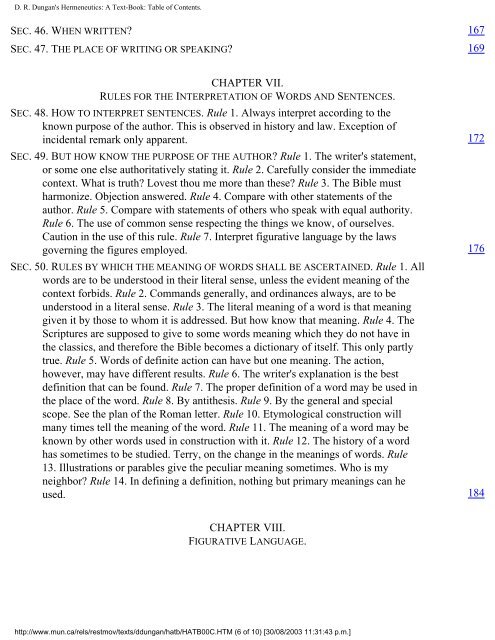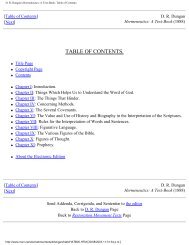Dungan - Hermeneutics
You also want an ePaper? Increase the reach of your titles
YUMPU automatically turns print PDFs into web optimized ePapers that Google loves.
D. R. <strong>Dungan</strong>'s <strong>Hermeneutics</strong>: A Text-Book: Table of Contents.<br />
SEC. 46. WHEN WRITTEN? 167<br />
SEC. 47. THE PLACE OF WRITING OR SPEAKING? 169<br />
CHAPTER VII.<br />
RULES FOR THE INTERPRETATION OF WORDS AND SENTENCES.<br />
SEC. 48. HOW TO INTERPRET SENTENCES. Rule 1. Always interpret according to the<br />
known purpose of the author. This is observed in history and law. Exception of<br />
incidental remark only apparent. 172<br />
SEC. 49. BUT HOW KNOW THE PURPOSE OF THE AUTHOR? Rule 1. The writer's statement,<br />
or some one else authoritatively stating it. Rule 2. Carefully consider the immediate<br />
context. What is truth? Lovest thou me more than these? Rule 3. The Bible must<br />
harmonize. Objection answered. Rule 4. Compare with other statements of the<br />
author. Rule 5. Compare with statements of others who speak with equal authority.<br />
Rule 6. The use of common sense respecting the things we know, of ourselves.<br />
Caution in the use of this rule. Rule 7. Interpret figurative language by the laws<br />
governing the figures employed. 176<br />
SEC. 50. RULES BY WHICH THE MEANING OF WORDS SHALL BE ASCERTAINED. Rule 1. All<br />
words are to be understood in their literal sense, unless the evident meaning of the<br />
context forbids. Rule 2. Commands generally, and ordinances always, are to be<br />
understood in a literal sense. Rule 3. The literal meaning of a word is that meaning<br />
given it by those to whom it is addressed. But how know that meaning. Rule 4. The<br />
Scriptures are supposed to give to some words meaning which they do not have in<br />
the classics, and therefore the Bible becomes a dictionary of itself. This only partly<br />
true. Rule 5. Words of definite action can have but one meaning. The action,<br />
however, may have different results. Rule 6. The writer's explanation is the best<br />
definition that can be found. Rule 7. The proper definition of a word may be used in<br />
the place of the word. Rule 8. By antithesis. Rule 9. By the general and special<br />
scope. See the plan of the Roman letter. Rule 10. Etymological construction will<br />
many times tell the meaning of the word. Rule 11. The meaning of a word may be<br />
known by other words used in construction with it. Rule 12. The history of a word<br />
has sometimes to be studied. Terry, on the change in the meanings of words. Rule<br />
13. Illustrations or parables give the peculiar meaning sometimes. Who is my<br />
neighbor? Rule 14. In defining a definition, nothing but primary meanings can he<br />
used. 184<br />
CHAPTER VIII.<br />
FIGURATIVE LANGUAGE.<br />
http://www.mun.ca/rels/restmov/texts/ddungan/hatb/HATB00C.HTM (6 of 10) [30/08/2003 11:31:43 p.m.]




